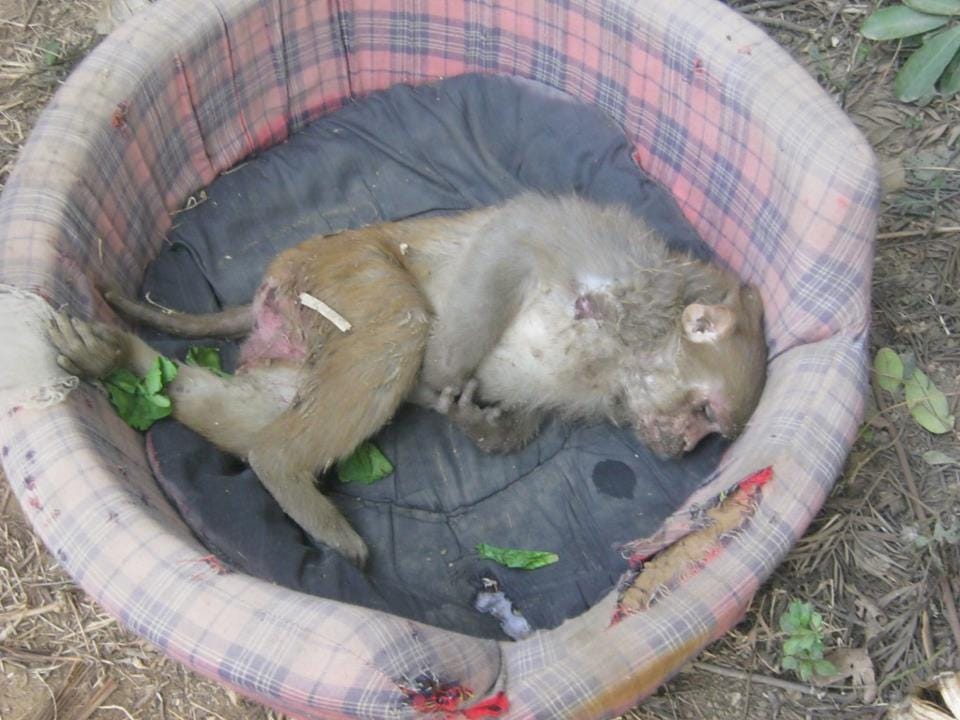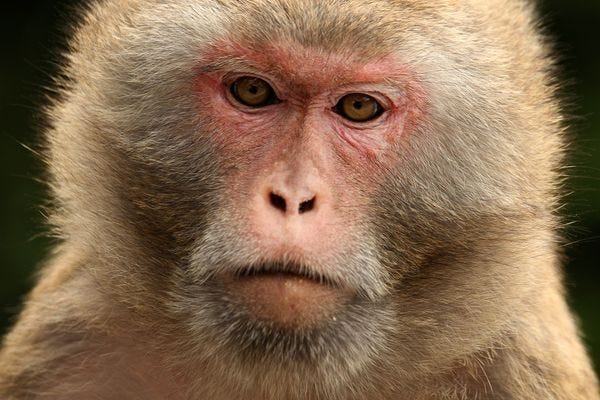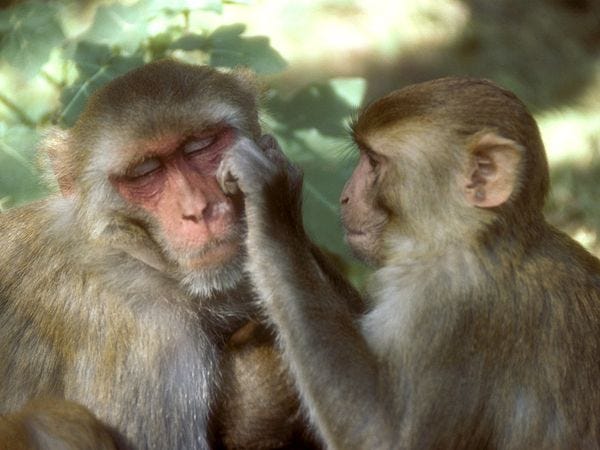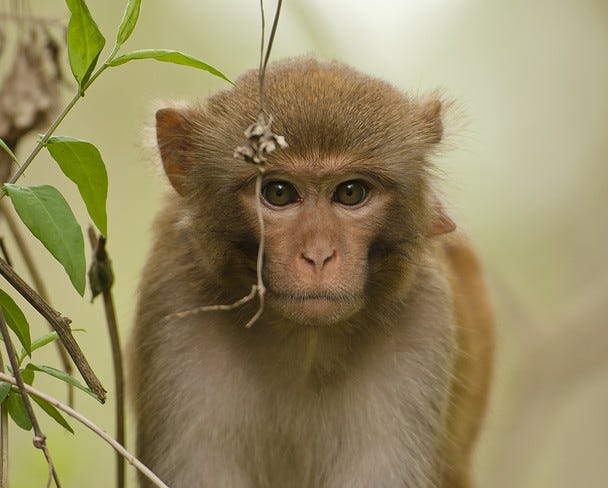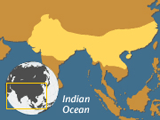The Tragedy of the Once Common Rhesus Monkey
An Interview with Michael Hutchins & Geeta Seshamani of Wildlife SOS
By Jordan Schaul | National Geographic | January 22, 2013
Contributing Editor Dr. Jordan Schaul examines the plight of the most wide-ranging, non-human primate on the planet—the rhesus monkey (aka the urban macaque). Included in this post are interviews with Wildlife SOS co-founder and professor Geeta Seshamani and distinguished wildlife biologist and professor Dr. Michael Hutchins.
Last week, Wildlife SOS came to the rescue of another animal victim—a casualty of human-urban wildlife conflict. Discovered, severely injured and in great distress near a farmhouse south of the metropolis of Delhi, a subadult, female rhesus macaque (Macaca mulatta) was in need of immediate veterinary attention.
The little monkey, suspected to be a transient release, had been attacked by a resident group of macaques patrolling their territory. The incident was reported near New Delhi, a city with an enormous populous, centrally located within the National Capital Territory of Delhi.
Rhesus macaques or rhesus monkeys, as they are often called, can be extremely aggressive, particularly while protecting their troop’s respective territory from intruders.
Evidently, this particular monkey (see photo) leaped onto an electric pole in an effort to escape the wrath of her conspecific pursuers. While leaping from one wire to another, she was unfortunately electrocuted. To complicate matters, some marauding dogs pounced on her as soon as she fell to the ground. Fortunately, local residents in the area, who heard the barks and growls of the dogs and the monkey’s crying vocalizations, came to her defense; they warded off the dogs and contacted Wildlife SOS’s wildlife rescue hotline to collect the animal.
The monkey appeared to be in shock and in a great deal of pain. The Wildlife SOS team rescued the monkey and she was carefully transported back to the clinic for treatment. Upon examination, it was determined that the macaque had, indeed, sustained severe burn injuries from the electrocution. Her prognosis was grave. The clinicians already felt that she would not survive given the combination of the burns, and other soft tissue injuries, but perhaps the shock was too much for the little primate to handle.
Despite all the veterinary attention, the little monkey succumbed to her injuries in the clinic a few hours after she was rescued. According to Wildlife SOS co-founder Geeta Seshamani, the female was most likely an unscientific “release” by a municipality or well-intentioned release by an animal activist ignorant about the species’ behavior and ecology.
Next to humans, the rhesus macaque is the most wide-ranging primate on the planet. These monkeys occur throughout Asia—most notably in China, India, Bhutan, Laos, Burma, Nepal, Bangladesh, Thailand, Vietnam, Pakistan, and Afghanistan. Although locally extinct in some regions, they are expanding their range in other areas.
Several subspecies of this macaque species occur, but we often simply distinguish individuals as Chinese or Indian-derived. Rhesus macaques, like many Old World monkeys, are prolific breeders and highly adaptable monkeys—some of the reasons they remain listed only as a species of Least Concern on the IUCN Red List of Threatened Species.
Among free-ranging populations, feral colonies of rhesus macaques exist outside of Asia. These include some troops in the United States, which are comprised of animals released into the wild by private owners and even by some laboratory scientists, as reported in past recovery incidents. Other individuals come from zoos and other captive wildlife facilities, where they are inadvertently returned to the wild as a result of intentional release or escape.
Besides their impressive range, these Old World primates also deserve the distinction of being the most well-known monkeys on the planet. They are diurnal and very comfortable in the trees or on the ground. You may not be familiar with the name “rhesus,” but you’d recognize one of these monkeys if you encountered one.
No longer displayed in most zoos, there are feral colonies of rhesus macaques in the United States. At least one of these feral populations was established as early as the 1930s. The rhesus macaques were once ubiquitous in zoos in North America and were often displayed in large “island” exhibits comprised of artificial rock surrounded by a moat. Ironically, these monkeys can swim quite well and so the water was not a deterrent for an escape. The gunite enclosures built in zoos were commonly referred to as “monkey island” exhibits. These “habitats” were surrounded by perimeter fencing or other barriers for the purpose of confining these renowned escape artists.
As mentioned, you won’t find any rhesus monkeys in accredited zoos today. A zoonotic and lethal-to-human Herpes B virus, carried by a great proportion of these animals, was implicated in the death of a Yerkes National Primate Research Center employee (http://www.ergriffinresearch.org/about-erg-research-foundation/). This incident influenced the display of these primates in public facilities. Concern for zoonotic transmission in zoos has contributed to the rhesus macaque’s disappearance from captive breeding and exhibition in captivity.
Although no longer featured as part of public displays in living collections of zoological parks, these charismatic primates are still bred for use in biomedical research—particularly infectious zoonoses studies.
Rhesus monkeys are also still in high demand for use in non-invasive research programs. For example, comparative psychologists and other cognitive scientists choose this species for conducting research in comparative psychology and other behavioral science disciplines. This is in part because rhesus monkeys and related macaque species are not only personable but quite intelligent.
Nat Geo video on rhesus monkey sociobiology (http://video.nationalgeographic.com/video/animals/mammals-animals/monkeys-and-lemurs/monkey_rhesus/)
Today, however, a ban on exporting Indian-derived animals precludes researchers from gaining access to monkeys, as does a shortage of captive breeding programs. The use of such “highly evolved” animals in invasive research programs has been strongly criticized by animal activists and even by some factions within the biomedical science community.
Regard for the species from a conservation perspective has, perhaps, contributed to the inaccessibility of rhesus macaques from outside of India. While some populations are certainly growing, others are subjected to the pressures of habitat loss and fragmentation and have essentially been rendered extinct.
The highly adaptable rhesus macaque has emerged as an urban primate in recent times, but despite its ability to embrace city life, it may not persist in metropolitan areas where people really want to extirpate them.
New Delhi is India’s largest city. Like most metropolitan cities in South Asia, it harbors a complexity of opportunities for negative human-animal interactions. Many of these negative interactions involve species that we as Westerners think of as inhabitants of densely forested and perhaps protected ecosystems. But just as we encounter urban wildlife from coyotes to raccoons and white-tailed deer in cities across much of the contiguous US, East Indians also encounter animals that have adapted quite well to an urban lifestyle. “In most cases, these animals have had no choice, but to adapt or perish as humans continue to encroach on wild lands on a global scale,” says Kartick Satyanarayan, the CEO and co-founder of Wildlife SOS. Kartick asserts that if other species could adapt to city life, we presume they would. Often, however, the plight of urban wildlife is dismissed because city dwellers typically consider urban wildlife to be a nuisance.
Although conservation efforts are sometimes incompatible with animal welfare interests, Wildlife SOS remains committed to both species preservation and the well-being of individual animals. The organization serves all wildlife, but it has a vested interest in developing sustainable management practices for threatened and endangered fauna, such as tigers, leopards, and elephants, among other imperiled species, which we hope will continue to live free in South Asia for years to come.
As a co-founder of Wildlife SOS Geeta Seshamani has said, “the plight of these non-human urban wildlife species is ignored mainly because they fall victim to circumstances in an urban setting and not in a wildlife park, sanctuary, or another forested land.” The professor concedes that the unplanned developments, destruction of trees, and natural habitat, in areas that were once the lungs of the city—the green belts—have led to the current situation in cities like Delhi. She said, “the problem will only intensify.”
Through an email correspondence—the way in which we typically communicate across the world—I interviewed Geeta about the rhesus macaques in Delhi:
Geeta: Historically, in Delhi, troops of rhesus macaques lived peacefully on what we called the Ridge—a highly forested and elongated green area in the heart of Delhi. Surreptitiously, areas became utilized for exercising polo horses, for army camp activities, and for various other “urgent” developmental needs of the city.
Both the nilgai (blue bull antelopes) and the rhesus macaques began to migrate from this area due to the excessive biotic disturbance by humans. They would crossroads, often getting injured in road accidents. If they survived the roads and the traffic, they would enter residential areas, and specifically people’s houses, gardens, backyards, and parks, seeking sustenance and shelter.
Jordan: How long has this been going on?
Geeta: The process started over a decade ago and now the consequences are rather severe, but wholly what one should have expected. Animal shelters are overrun with injured monkeys, some of which are older single monkeys bitten by a member of another troop (the consequence of trapping individual animals and releasing them without thought or plan); or attacked by the dogs living in the streets. Lastly, some of these monkeys are injured by intolerant and perceived-to-be sadistic humans. Oddly some people are all too eager to throw scalding hot oil, water, and sometimes acid on the monkeys if they enter decks or balconies of homes.
Jordan: Are specific cohorts affected?
Geeta: Injured females seek to protect their young and get injured quite a bit. So frequently, the mothers are badly injured in the process of saving their babies. Often their spines are severed and they die within a few hours of rescue, leaving behind tiny infants that have to be hand-raised and given a lifetime of care, as there is no safe place for release.
For example, Friendicoes (www.friendicoes.org), a sister organization of Wildlife SOS working with domestic animals, has rescued and in some cases fostered hundreds of baby monkeys in the course of the decade. Another frequent reason for monkeys having to be “rescued” is electrocution. In the place of trees, the macaques have adapted to using electrical structures and telephone posts, and high-tension wires as their arboreal habitat.
Jordan: What about the demographic of pet monkeys that have been released into nature? These individuals are typically unprepared to live in the wild and are most likely unaccepted by wild or feral troops?
Geeta: Many of which are rescued, are “pet monkeys” from the entertainment trade. They are most unwisely and unthinkingly “released” or “given freedom” by simply cutting their ropes. The bewildered animals, never having been away from their master—their “family“ so to say, seek human company only to find themselves “attacked.” As a consequence and only naturally, they typically react aggressively, going on a rampage, biting people. At least fifty percent of the rescued adults are such “pets”.
Our recent rescue in Delhi was really quite an ill-mannered monkey. However, the primate attacked five women before we caught him. Once under our supervision in “disciplinary” quarters, if you will, where he “knew” how he would be treated and how he was “expected” to behave, the monkey progressed quite well. Hence, we have not had a lot of trouble with him attacking keepers or even attempting to escape. We suspect that he was the victim of provocation and abuse. It is not a surprise that he attacked the women under the circumstances.
Jordan: Can we resolve such human-nonhuman primate conflict?
Geeta: There is still a lot to be learned about primate behavior as well as teaching an ethic of responsible animal treatment in the context of helping them. Simplistic solutions like “cutting the rope” to “free” the performing monkey will not work. Neither does the solution that municipalities (civic agencies in charge of cities infrastructures) adopt, which is to simply catch the monkeys. Usually, one or two out of a hierarchically balanced troop are caught. Releasing them randomly only serves to aggravate the situation. It typically makes the disturbed troop vengeful and renders the single individual fearful and aggressive. In short, this all leads to more conflict behavior. It is a ridiculous solution to a problem; it definitely doesn’t help to try to encourage monkeys and men to coexist in the same spaces.
Jordan: What about in Agra where we manage the largest captive sloth bear facility in the world?
Geeta: Monkeys were never a “problem” at the Bear Rescue and Rehabilitation Facility in Agra until quite recently. Today, the bear center, which sits on one side of the river, is overrun with over 200 rhesus macaques—mainly females and their offspring. The monkey population is comprised of animals that were “captured” by the local municipality in the city of Agra and “released” into the “jungle” in the outskirts of the city.
The truth is that the site of release was not selected properly and is a poor choice, as it is comprised of degraded jungle habitat with limited food availability for these primates. Those that have not moved on to nearby villages (about 50% did) probably discovered that our ursid rescue facility was their only hope of getting some sustenance. So the monkeys at our facility are able to survive by stealing the bears’ scatter feed, and by eating the leftovers of human meals, mainly fruits and porridge. They also carry out little “raids “ on the trucks bringing in milk or vegetables. We hope such unwise relocation of monkeys into habitats that cannot sustain them is discontinued.
Wildlife SOS works with state forest departments across India to address human-wildlife conflict and helps develop conflict mitigation methods.
Interview with Michael Hutchins:
Jordan: Was there a singular event (like the death of the Yerkes Regional Primate Center researcher) that prompted zoo associations/zoos to phase macaques out of living collections or was there a response to a growing body of clinical research on the Herpes B viral pathogen that prompted zoos to discontinue conservation-breeding efforts for macaque species?
Michael: There seems to be a confluence of factors that contributed to zoos phasing out some macaque species from their collections. First, the populations of many primate species were not large or genetically diverse enough to sustain them over the long term. Second, the importation of primates has become much more difficult, especially as some species have become threatened or endangered in the wild. While the potentially fatal Herpes B virus may be an additional factor contributing to the elimination of macaques from some institutions, the risks of infection appears to be low. In 1996, the AZA Old World Monkey TAG reprinted an article on Herpes B in macaques, which stated that “Zoos should be able to continue to maintain macaques safely with little stress to the keeper force if they adopt a plan that provides preventative methods and education to zoo employees.”
Jordan: How does this concern over the zoonotic monkey B virus, as it is sometimes called, impact the conservation of endangered species like the lion-tailed macaque, a relative of the rhesus monkey of which 300+ were last reported in the global captive population?
Michael: The question is somewhat moot. Rehabilitation (release of wild-born animals after temporary captivity) of non-human primates has met with some success, but that is different from the reintroduction of captive-bred individuals. With the notable exception of Brazil’s golden lion tamarin, successful reintroductions of captive-bred non-human primates are almost non-existent. This brings into question the utility of captive breeding programs to augment in situ conservation, at least for some species. That is not to say that successful and reliable techniques can never be developed, only that they do not currently exist. This makes it even more imperative that threatened and endangered non-human primate species are conserved in their natural habitats.
Jordan: Monkeys make terrible pets. Have non-human primate zoonoses impacted the trade in exotic pets, in your opinion, for better or worse?
Michael: As you note, monkeys and apes make terrible pets and I’m not sure why anyone would want one. They are destructive, defecate profusely, require special care and diets, and, once they reach sexual maturity, can become highly aggressive and dangerous. Since 1975, importations of non-human primates have been carefully regulated by the Centers for Disease Control and Prevention, primarily due to the risk of disease transmission. At present, monkeys and other nonhuman primates may not be imported as pets under any circumstances. Importation is strictly controlled through a registration process. These regulations are in place to protect U.S. citizens from zoonotic disease agents that can spread from monkeys to humans, which, among others, include Ebola, B virus, monkeypox, yellow fever, simian immunodeficiency virus, and tuberculosis. Under current law, importers must register with the CDC, implement disease control measures, and distribute non-human primates only for bona fide scientific, educational, or exhibition purposes, as specifically defined in the regulations.
Despite those restrictions, there is a burgeoning trade in non-human primates as pets. Captive-bred primates are produced by private breeders, roadside zoos, and circuses with stock that entered the U.S. before current regulations were established. It is uncertain how many primates enter the trade each year, but the number is estimated to be in the thousands. Some states have enacted legislation that restricts private individuals from owning the largest and most dangerous species—but laws vary from state to state.
The welfare of non-human primates is often compromised in such situations and many, including myself, have argued that the trade of non-human primates as pets should be shut down. But, the pet industry lobby is very powerful, and obtaining new regulations is often difficult. Of course, if such restrictions were established, what would be done with the current animals in private hands? I’m not sure the public would tolerate the widespread use of euthanasia. So, like it or not, the abusive, inhumane, and disrespectful tradition of primates as pets will likely continue. Long-term, education will be the key to shutting down the trade. If people do not buy primates as pets, then the industry will be forced to reevaluate. Economics, not ethics, may be the most powerful force for change.
Jordan: Are non-human primate models still a necessity for biomedical researchers or have alternative animal models along with technological advances essentially rendered the non-human primate model unnecessary?
Michael: That depends on who you ask. Animal rights activists would like to see all research on live animals discontinued, including research on non-human primates. Rights proponents are typically the ones that argue that alternatives, such as computer models, can fully and effectively replace research on live animals. That may be true in some selected cases. However, biomedical researchers claim that animal models are essential for testing various drugs and procedures that can then be transferred to humans. There is no doubt that animal research on cancer, heart disease, epilepsy and other human maladies has saved or improved millions of lives. In addition, it should be noted that animal research is now closely monitored and regulated to ensure that welfare is maximized and that any pain or loss of life is both justified and minimized.
Jordan: In your opinion are the enrichment programs, now mandated for inclusion in the management of captive primates in zoos and laboratories, adequate for these species?
Accredited zoos and laboratories have come a long way in the past couple of decades, but is it sufficient? It is probably not. In particular, zoos need to develop a scientific basis for their enrichment programs. It is not enough to provide enrichment and assume it is effective; one needs to be able to demonstrate that it is making a difference from the animals’ perspective. For example, boomer balls are a common enrichment device used for a wide range of animals. Initially, these objects may elicit a great deal of activity and attention, but once the animal becomes habituated to it, its effectiveness may be lessened. Research investigating the relationship between management/enrichment techniques with animal behavior (e.g., play, activity), heart rate, stress hormones, health, and longevity might go a long way towards providing a strong scientific basis and justification for particular approaches. University laboratories have generally done a better job in this regard, often hiring researchers to specifically evaluate the effectiveness of various enrichment techniques. Zoos have borrowed from this literature, but it is important to note that their facilities and care programs, and the species they work with, are quite different. The challenge for zoos is much greater because of the diversity of exotic species they maintain, ranging from insects to birds, to amphibians and reptiles to mammals.
Fast Facts on Rhesus Macaques
Average life span in the wild:4 years Size:Head and body, 17.75 to 25 in (45 to 64 cm); tail, 7.5 to 12.5 in (19 to 32 cm) Weight:8.75 to 26.5 lbs (4 to 12 kg) Size relative to a 6-ft (2-m) man:
ABOUT NATIONAL GEOGRAPHIC SOCIETY
The National Geographic Society is a global nonprofit organization that uses the power of science, exploration, education and storytelling to illuminate and protect the wonder of our world. Since 1888, National Geographic has pushed the boundaries of exploration, investing in bold people and transformative ideas, providing more than 14,000 grants for work across all seven continents, reaching 3 million students each year through education offerings, and engaging audiences around the globe through signature experiences, stories and content. To learn more, visit www.nationalgeographic.org or follow us on Instagram, Twitter and Facebook.
MEET THE AUTHOR
Jordan Carlton SchaulWith training in wildlife ecology, conservation medicine, and comparative psychology, Dr. Schaul's contributions to Nat Geo Voices have covered a range of environmental and social topics. He draws particular attention to the plight of imperiled species highlighting issues at the juncture or nexus of sorta situ wildlife conservation and applied animal welfare. Sorta situ conservation practices are comprised of scientific management and stewardship of animal populations ex situ (in captivity / 'in human care') and in situ (free-ranging / 'in nature'). He also has a background in behavior management and training of companion animals and captive wildlife and conservation marketing and digital publicity. Jordan has shared interviews with colleagues and public figures, as well as editorial news content. In addition, he has posted narratives describing his own work, which include the following examples: • Restoration of wood bison to the Interior of Alaska while (As Animal Curator at Alaska Wildlife Conservation Center and courtesy professor at the University of Alaska) • Rehabilitation of orphaned sloth bears exploited for tourists in South Asia (As executive consultant 'in-residence' at the Agra Bear Rescue Center managed by Wildlife SOS) • Censusing small wild cat (e.g. ocelot and margay) populations in the montane cloud forests of Costa Rica for popular publications with 'The Cat Whisperer' Mieshelle Nagelschneider • Evaluating the impact of ecotourism on marine mammal population stability and welfare off the coast of Mexico's Sea of Cortez (With Boston University's marine science program) Jordan was a director on boards of non-profit wildlife conservation organizations serving nations in Africa, North and South America and Southeast Asia. He is also a consultant to a human-wildlife conflict mitigation organization in the Pacific Northwest. Following animal curatorships in Alaska and California, he served as a charter board member of a zoo advocacy and outreach organization and later as its executive director. Jordan was a member of the Communication and Education Commission of the International Union for the Conservation of Nature (CEC-IUCN) and the Bear Specialist Group of the IUCN Species Survival Commission (BSG-SSC-IUCN). He has served on the advisory council of the National Wildlife Humane Society and in service to the Bear Taxon Advisory Group of the Association of Zoos and Aquariums (AZA Bear TAG). In addition, he was an ex officio member of the council of the International Association for Bear Research and Management.



